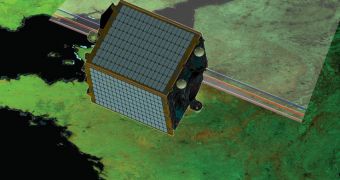Creating a satellite that is capable of identifying minute variations in the way vegetation on our planet changes each day is a monumental task in and by itself. But creating a machine capable to do this and still measure less than a cubic meter in size brings space engineering to new heights. This is precisely the goal of the European Space Agency's (ESA) Proba V mission, which will be a microsatellite designed specifically to fulfill the same tasks as the wide-swath “Vegetation” camera, which is installed aboard the French-built Spot-5 satellite. For the record, the latter instrument is massive compared to Proba V.
The powerful camera that the new microsatellite will carry is so small that it easily fits on a laboratory table. Still, it needs to be powerful enough to record worldwide vegetation variations daily. In order to do this, ESA engineers have adopted a construction technique in which they even replaced glass as the material used to create the camera's mirrors. Instead, they used aluminum-based mirrors for the job, on account of the fact that these instruments are lighter, and capable of the same performances.
Additionally, three separate telescopes were combined in the same optical instrument, with the goal of obtaining the wide-field view necessary for broad coverage. Overall, the satellite's technology had to be reduced by a factor of ten from its original size. Recently, scientists at the European Space Research and Technology Center (ESTEC), in Noordwijk, the Netherlands, subjected a test version of such a camera to unforgiving tests. The facility's Mechanical Systems Laboratory simulated the harsh conditions of space by exposing the camera to extremely low temperatures, while in hard vacuum.
“We are checking the instrument temperature stays within set limits. Because its three telescopes have overlapping views, any temperature-driven deformation could put them out of alignment,” explains Jorg Versluys, who is an expert at the Belgium-based company OIP. The firm is under contract with ESA to construct the optical instrument under extremely narrow margins for errors. Speaking of the challenges still ahead in seeing the mission launched, Karim Mellab said “Proba-V’s Vegetation payload will need to be operational on top of its experimental nature.” He is the Proba V project manager at ESA. “One of our main objectives is to get the new sensor in orbit by mid-2012. This will give us overlap with Spot-5’s Vegetation sensor, allowing us to calibrate the new instrument,” he concludes.

 14 DAY TRIAL //
14 DAY TRIAL //